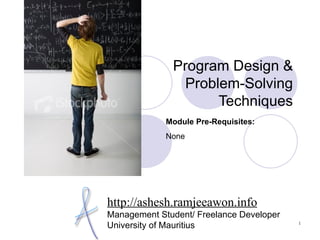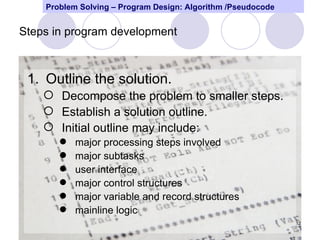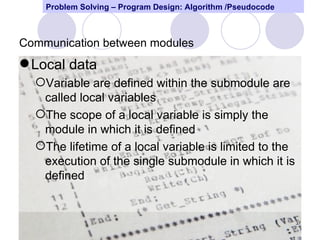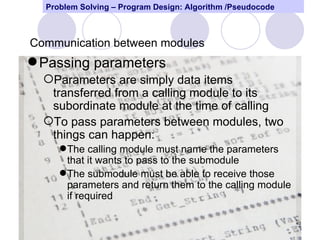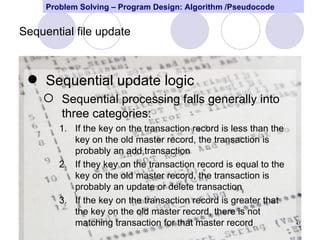Program design and problem solving techniques
- 1. Program Design & Problem-Solving Techniques Module Pre-Requisites: None http://ashesh.ramjeeawon.info Management Student/ Freelance Developer University of Mauritius 1
- 2. Problem Solving – Program Design: Algorithm /Pseudocode Today’s Session Steps in program development Algorithmic Problem Solving How to write Pseudocode? Meaningful names Structure Theorem Communication between modules Module Cohesion and Coupling Sequential File update 2
- 3. Problem Solving – Program Design: Algorithm /Pseudocode Problem Solving - Big Problemo!!! 3
- 4. Problem Solving – Program Design: Algorithm /Pseudocode How Do We Write a Program? A computer is not intelligent. It cannot analyze a problem and come up with a solution. A human (the programmer) must analyze the problem, develop the instructions for solving the problem, and then have the computer carry out the instructions. To write a program for a computer to follow, we must go through a two-phase process: problem solving and implementation 4
- 5. Problem Solving – Program Design: Algorithm /Pseudocode Problem-Solving Phase Analysis and Specification. Understand (define) the problem and what the solution must do. General Solution (Algorithm). Specify the required data types and the logical sequences of steps that solve the problem. Verify. Follow the steps exactly to see if the solution really does solve the problem. 5
- 6. Problem Solving – Program Design: Algorithm /Pseudocode Implementation Phase Concrete Solution (Program). Translate the algorithm (the general solution) into a programming language. Test. Have the computer follow the instructions. Then manually check the results. If you find errors, analyze the program and the algorithm to determine the source of the errors, and then make corrections. Once a program has been written, it enters a third phase: maintenance. 6
- 7. Problem Solving – Program Design: Algorithm /Pseudocode Maintenance Phase Use. Use the program. Maintain. Modify the program to meet changing requirements or to correct any errors that show up while using it. The programmer begins the programming process by analyzing the problem, breaking it into manageable pieces, and developing a general solution for each piece called an algorithm. The solutions to the pieces are collected together to form a program that solves the original problem. Understanding and analyzing a problem take up much more time than Figure 1.1 implies. They are the heart of the programming process. 7
- 8. Problem Solving – Program Design: Algorithm /Pseudocode 8
- 9. Problem Solving – Program Design: Algorithm /Pseudocode Compiler and Interpreters 9
- 10. Steps in program development Ref: 10
- 11. Problem Solving – Program Design: Algorithm /Pseudocode Steps in program development 1. Define the problem into three separate components: inputs outputs processing steps to produce required outputs. 11
- 12. Problem Solving – Program Design: Algorithm /Pseudocode Steps in program development 1. Outline the solution. Decompose the problem to smaller steps. Establish a solution outline. Initial outline may include: major processing steps involved major subtasks user interface major control structures major variable and record structures mainline logic 12
- 13. Problem Solving – Program Design: Algorithm /Pseudocode Steps in program development 1. Develop the outline into an algorithm. The solution outline is now expanded into an algorithm. What is an algorithm? – a set of precise steps that describe exactly the tasks to be performed and the order in which they are to be carried out. Pseudocode will be used to represent the solution algorithm 13
- 14. Problem Solving – Program Design: Algorithm /Pseudocode Steps in program development 1. Test the algorithm for correctness. Very important in the development of a program, but often forgotten Major logic errors can be detected and corrected at an early stage Go through the algorithm step-by-step with test data to ensure the program will actually do what it is supposed to do. 14
- 15. Problem Solving – Program Design: Algorithm /Pseudocode Steps in program development 1. Code the algorithm into a specific programming language. Start to code the program into a chosen programming language after all design considerations from Steps 1–4 are met. 15
- 16. Problem Solving – Program Design: Algorithm /Pseudocode Steps in program development 1. Run the program on the computer. This step uses a program compiler and programmer-designed test data to machine- test the code for syntax errors logic errors 16
- 17. Problem Solving – Program Design: Algorithm /Pseudocode Steps in program development 1. Document and maintain the program. Is really an ongoing task from the initial definition of the problem to the final test Documentation involves: external documentation internal documentation 17
- 18. Problem Solving – Program Design: Algorithm /Pseudocode Algorithmic Problem Solving 18
- 19. Problem Solving – Program Design: Algorithm /Pseudocode An introduction to algorithms and pseudocode What is an algorithm? Lists the steps involved in accomplishing a task (like a recipe) Defined in programming terms as ‘a set of detailed and ordered instructions developed to describe the processes necessary to produce the desired output from a given input’ 19
- 20. Problem Solving – Program Design: Algorithm /Pseudocode An introduction to algorithms and pseudocode What is an algorithm? An algorithm must: Be lucid, precise and unambiguous Give the correct solution in all cases Eventually end 20
- 21. Problem Solving – Program Design: Algorithm /Pseudocode An introduction to algorithms and pseudocode What is pseudocode? Structured English (formalised and abbreviated to look like high-level computer language) 21
- 22. Problem Solving – Program Design: Algorithm /Pseudocode How to write pseudocode There are six basic computer operations: 1. A computer can receive information 2. A computer can put out information 3. A computer can perform arithmetic 4. A computer can assign a value to a variable or memory location 5. A computer can compare two variables and select one of two alternate actions 6. A computer can repeat a group of actions 22
- 23. Problem Solving – Program Design: Algorithm /Pseudocode Exercise Time Do some reading on the website below: http://www.cs.dartmouth.edu/~fabio/teaching/c 23
- 24. Problem Solving – Program Design: Algorithm /Pseudocode Meaningful names When designing an algorithm, a programmer must introduce some unique names which represents variables or objects in the problem. Names should be meaningful. Names should be transparent to adequately describe variables (Number1, number2, etc.). 24
- 25. Problem Solving – Program Design: Algorithm /Pseudocode Meaningful names Underscore is used when using more than one word (sales_tax or word_count). Most programming language does not tolerate a space in a variable as space would signal the end of a variable name. Another method is to use capital letters as a word separator (salesTax or wordCount). 25
- 26. Problem Solving – Program Design: Algorithm /Pseudocode The Structure Theorem 26
- 27. Problem Solving – Program Design: Algorithm /Pseudocode The Structure Theorem 1. Sequence Straightforward execution of one processing step after another Represents the first four basic computer operations 1. Receive information 2. Put out information 3. Perform arithmetic 4. Assign values 27
- 28. Problem Solving – Program Design: Algorithm /Pseudocode The Structure Theorem A typical sequence statement in an algorithm might read: Add 1 to pageCount Print heading line1 Print heading line2 Set lineCount to zero Read customer record These instructions illustrate the sequence control structure as a straightforward list of steps written one after the other, in a top-to-bottom fashion 28
- 29. Problem Solving – Program Design: Algorithm /Pseudocode The Structure Theorem 1. Selection Presentation of a condition and the choice between two actions, the choice depending on whether the condition is true or false Represents the decision-making abilities of the computer Illustrates the fifth basic computer operation – compare two variables and select one of two alternate actions 29
- 30. Problem Solving – Program Design: Algorithm /Pseudocode The Structure Theorem In pseudocode, selection is represented by the keywords IF, THEN, ELSE and ENDIF IF condition p is true THEN statement(s) in true case ELSE statement(s) in false case ENDIF If condition p is true, then the statement in true case will be executed, and the statement in the false case will be skipped (vice versa) 30
- 31. Problem Solving – Program Design: Algorithm /Pseudocode The Structure Theorem 1. Repetition Presentation of a set of instruction to be performed repeatedly, as long as the condition is true Block statement is executed again and again until a terminating condition occurs Illustrates the sixth basic computer operation – to repeat a group of actions. 31
- 32. Problem Solving – Program Design: Algorithm /Pseudocode The Structure Theorem Written in pseudocode as: DOWHILE condition p is true statement block ENDDO DOWHILE is a leading decision loop – condition is tested before any statements are executed ENDDO triggers a return of control to the retesting of the condition Condition is true, statements are repeated until condition is found false 32
- 33. Problem Solving – Program Design: Algorithm /Pseudocode Exercise Time In a complete program/ algorithm, show the 3 concepts of Structure Theorem 33
- 34. Problem Solving – Program Design: Algorithm /Pseudocode Communication between modules Necessary to consider flow of information between modules This flow of information is called ‘intermodule communication’ and can be accomplished by the scope of the variable 34
- 35. Problem Solving – Program Design: Algorithm /Pseudocode Communication between modules Scope of a variable The portion of a program in which that variable has been defined and to which it can be referenced Variables can be global where the scope of the variable is the whole program Scope of the variable is simple the module which it is defined 35
- 36. Problem Solving – Program Design: Algorithm /Pseudocode Communication between modules Global data Date that can be used by all the modules in a program Every module in the program can access and change data Lifetime of a global variable spans the execution of the whole program 36
- 37. Problem Solving – Program Design: Algorithm /Pseudocode Communication between modules Local data Variable are defined within the submodule are called local variables The scope of a local variable is simply the module in which it is defined The lifetime of a local variable is limited to the execution of the single submodule in which it is defined 37
- 38. Problem Solving – Program Design: Algorithm /Pseudocode Exercise time Show the difference between a global variable and a local variable via the use of a program, in any language of your choice. 38
- 39. Problem Solving – Program Design: Algorithm /Pseudocode Communication between modules Side effects Side effect is a form of a cross-communication of a module with other parts of a program, Occurs when a subordinate module alters the value of a global variable inside a module 39
- 40. Problem Solving – Program Design: Algorithm /Pseudocode Communication between modules Passing parameters Parameters are simply data items transferred from a calling module to its subordinate module at the time of calling To pass parameters between modules, two things can happen: The calling module must name the parameters that it wants to pass to the submodule The submodule must be able to receive those parameters and return them to the calling module if required 40
- 41. Problem Solving – Program Design: Algorithm /Pseudocode Communication between modules Formal and actual parameters Parameters names that appear when a submodule is defined are known as formal parameters Variables and expressions that are passed to a submodule in a particular call are called actual parameters 41
- 42. Problem Solving – Program Design: Algorithm /Pseudocode Communication between modules Value and reference parameters Parameters may have one of three function: 1. To pass information from a calling module to a subordinate module 2. To pass information from a subordinate module to its calling module 3. To fulfil a two-way communication role 42
- 43. Problem Solving – Program Design: Algorithm /Pseudocode Communication between modules Value and reference parameters Value parameters Value parameters pass a copy of the value of a parameter from one module to another Reference parameters Reference parameter pass the memory address of a parameter from one module to another 43
- 44. Problem Solving – Program Design: Algorithm /Pseudocode Module cohesion Cohesion is a measure of the internal strength of a module It indicates how closely the elements or the statements of a module are associated with each other The more closely the elements of a module are associated with each other, the higher the cohesion of the module 44
- 45. Problem Solving – Program Design: Algorithm /Pseudocode Module coupling Coupling is a measure of the extent of information interchange between modules Tight coupling implies large dependence on the structure of one module by another Loose coupling is the opposite of tight coupling. Modules with loose coupling are more independent and easier to maintain 45
- 46. Problem Solving – Program Design: Algorithm /Pseudocode Sequential file update Master file Is a file that contains permanent and semi- permanent information about the data entities it contains Transaction file Contains all the data and activities that are included on the master file. These are transactions to: Add a new record Update or change an existing record Delete an existing record 46
- 47. Problem Solving – Program Design: Algorithm /Pseudocode Sequential file update Sequential update logic Sequential processing falls generally into three categories: 1. If the key on the transaction record is less than the key on the old master record, the transaction is probably an add transaction 2. If they key on the transaction record is equal to the key on the old master record, the transaction is probably an update or delete transaction 3. If the key on the transaction record is greater that the key on the old master record, there is not matching transaction for that master record 47
- 48. Problem Solving – Program Design: Algorithm /Pseudocode The End – Thank you for your kind attention References: Simple Program Design – A step by step approach by L. A. Robertson 48
- 49. Problem Solving – Program Design: Algorithm /Pseudocode http://ashesh.ramjeeawon.info Management Student/ Freelance Developer University of Mauritius BCS Student Member 49

